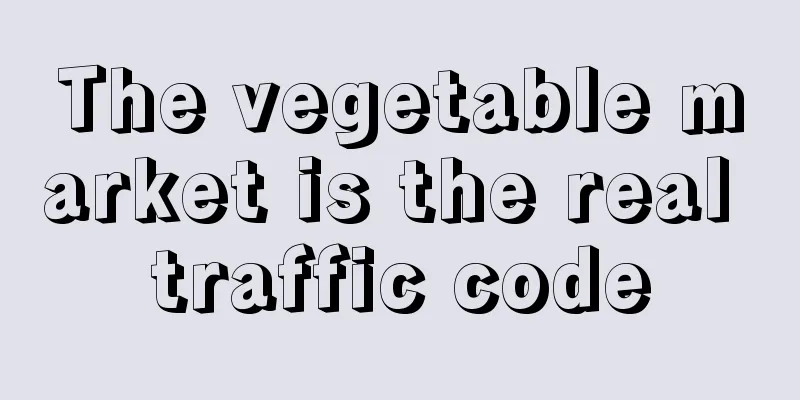Do you understand the "people, goods, and venue" model? Data analysis can be used in most scenarios!

Many students who do data analysis have heard of the analysis model of people, goods, and places. However, this thing is something that is only heard of in name but not in reality. How can we combine it with actual analysis? Today we will explain it systematically. Problem scenario: For a certain fresh food e-commerce company, the user repurchase rate is low, with 60% of users not making a second purchase within 30 days. The operations leader is very anxious and requires improving the repurchase rate through data analysis. As a data analyst, what should you do? A. Establish an AI-based precise recommendation algorithm (40% probability of using collaborative filtering, 60% probability of using association analysis) B. Make a line graph of the repurchase rate at the beginning of the past six months, and then write down three powerful words: "Go for it!" C. What is there to analyze? Isn’t e-commerce just about issuing coupons? All non-repurchase users will be issued coupons. Just do it! Or do you have another solution? 1. Cargo attribute analysisLet me ask you a simple question: What is the difference between rice, flour, a bucket of oil, and strawberries, cherries, and mangosteens? Even if you have never bought vegetables, you know that rice, flour, and oil are things you have to eat every day, and they are not seasonal; strawberries, cherries, and mangosteens are not eaten every day, and they are very seasonal. If you go to the market or supermarket, you will find that rice, flour and oil are usually sold in bags or barrels. A barrel can last for a long time, and there are special rice barrels, rice boxes and oil bottles for packaging. Strawberries and mangosteens are usually sold separately and are not durable. If you don't eat them after a few days, they will go bad. These seemingly common product knowledge are collectively referred to as: product attributes. Product attributes will directly affect consumer purchasing behavior:
Purchase channel: If there is logistics delivery, it is more convenient to buy large hard currency (rice, flour and oil) online, and buy loose items offline. It is best to try a few on-site to avoid pitfalls. These commodity properties are common sense and natural laws, and will not change due to the calculation method of data indicators. Therefore, in fresh products, user behavior will be directly affected by past purchases - you can't expect a user to buy 10 kilograms of rice just now and then buy another 10 kilograms in two days. In other words, if there are really users who come to buy rice repeatedly, then you have to check whether the rice you provide is much cheaper than the market price, and whether someone is taking advantage of it. There is a simple matrix model that can describe the repurchase ideas of fresh products. The core is the product purchase frequency and product relevance. The purchase frequency has been explained above, and product relevance means that some products are naturally bought together. Especially in the field of fresh food, for example, if you buy frozen chicken wings and bamboo skewers, you are likely to buy charcoal, meatballs, and barbecue sauce. Therefore, the intersection of the two dimensions has the following matrix (as shown below). But please note that it is incomplete to only look at it from the perspective of the attributes of goods. There are many channels for buying vegetables, why do users have to poke around in the app? Isn't the vegetable market attractive? What is the appeal of APP/micro mall? This involves: the problem of the market. 2. Analysis of store attributesQuick question: What are you going to eat for lunch today? Don’t think, just answer! Ten out of ten students can't answer it, right? In fact, if you are asked to answer "Are you hungry?", you will have to struggle for more than ten or twenty minutes, not to mention preparing in advance. The same is true for buying groceries. Why do the elderly like to go to the vegetable market? One important reason is that cooking is not purposeful, so they buy whatever they like on the spot. Secondly, they can compare prices and choose fresh and cheap ones. The visual impact of the vegetable market, including the fresh food area of the supermarket, is much stronger than that of e-commerce. This is the impact of the attributes of the store on repurchase behavior. Store attributes, including:
In traditional offline stores, there is also a matrix model for store locations. (As shown below) The indicators used by online channels are similar to those used by offline channels, except that the user's login scenario, login frequency, and content accessed after login replace the distance to the store. Online channels can do much more analysis on content and jump paths than offline channels. Interestingly, unlike fast-moving consumer goods such as clothing, snacks, and toys, in the field of fresh food, the online channel experience is worse than the offline channel. Therefore, the advantage of online fresh food is reflected in the scenarios where you cannot go out, such as rainy days, traffic control during the epidemic, no time to go to the vegetable market during commuting, etc. However, this leads to the third problem: some users may simply seek cheap prices, while some users really have an urgent need to buy online. Therefore, the human factor must be considered. 3. User Attribute AnalysisNote that in traditional industries, people, goods, and places are used. People refer to salespeople, not consumers. The so-called labor efficiency refers to the average economic benefits generated by salespeople. However, Internet applications are apps for users, and there is no sales concept. Therefore, salespeople are changed to users, and the so-called human analysis becomes user attribute analysis. When it comes to user attributes, many students' conditioned reflex is: gender, age, region. The question is, can your company really collect so much real user information? Moreover, these fields may not necessarily show anything. The most typical example is gender. The difference in the ratio of men to women is often only a few points, which can explain nothing. It would be more useful to label based on interaction and consumption behavior. For example, in the field of fresh food e-commerce, how many customers are attracted by such activities as 20 yuan rice, flour and oil coupons for registration, free delivery for the first order, and 25 yuan for 4 kilograms of imported cherries. These are called promotion-sensitive users. Similarly, you can also label: rigid purchase users, abnormal weather purchase users, epidemic area users, etc., which may have higher differentiation (as shown in the figure below). 4. Construction of the people-cargo-yard modelWith a basic understanding of the three dimensions, we can use them to comprehensively explain the problem. Back to the question at the beginning, "The repurchase rate of fresh food e-commerce is low." We can first establish an analytical hypothesis from the perspective of people, goods, and places: Human perspective:
Cargo angle:
Field Angle:
After establishing your own assumptions, there are two ways to build an overall idea:
(As shown below) Finally, we can combine the various analysis dimensions to form an overall analysis logic and draw conclusions from coarse to fine details (as shown in the figure below). V. SummaryThe three dimensions of people, goods, and places are often used because they are directly related to user behavior, and there are some natural rules to follow for product attributes, store attributes, and user habits. Therefore, they are very suitable as the basis for analysis and can be done in depth and detail. On the one hand, it can give you a clearer understanding of the business; on the other hand, it can also provide clues for building more complex models. However, the common problem in the industry now is that newcomers in the business only know how to issue coupons, and they use coupons to solve the unspeakable problems, and they call it: Internet thinking is free! Newcomers in data work only know RFM and correlation analysis, and they think of collaborative filtering when they talk about models. Please, brothers, with the user stickiness of your platform, 60% to 71% of users log in, and they are born with coupons. How much real data do you have to train your model? Just like the fresh food e-commerce industry, it would be much more useful to go to the market a few times and talk to the main group of people who buy food: uncles, aunts, and housewives, than to discuss AARRR with colleagues who are hungry every day. You can give it a try. Author: Down-to-earth Teacher Chen Source public account: Down-to-earth Teacher Chen (ID: 773891) |
<<: I'll be frank: China's marketing has changed dramatically
>>: With beauty product sales declining, is Bilibili a new oasis?
Recommend
The search volume of Xiaohongshu has increased sharply. Is Baidu worried?
"Xiaohongshu search rises, challenges Baidu&#...
How to open a store in shein? What are the advantages of shein?
Shein is a cross-border brand that has developed o...
The most discouraging Spring Festival marketing campaign in the Year of the Snake! Major brands are rolling up their sleeves
As the Spring Festival of the Year of the Snake ap...
Amazon Saudi Arabia and the UAE, which one is better? How to choose?
If you want to open a store on Amazon, you must fi...
Are Shopee and Lazada doing well now? Detailed analysis
If you want to open a store online, you can consid...
How much conversion rate does an independent website have to earn money? What are the ways to improve it?
At present, there are many businesses that have in...
ChatGPT and visual search are changing the search market landscape
With the rapid development of artificial intellige...
Breaking down the 12 types of Douyin bloggers, which one is the easiest to make money?
In today's era of rampant traffic and short vi...
How do I use the Amazon Refurbished link? How long is the new product period?
For Amazon merchants, they need to pay attention t...
Reviewing the 60+ years of Barbie’s evolution, why has this brand been so popular for so many years?
Recently, Barbie fans are everywhere in the street...
What is the difference between Amazon's Flash Sales and Seven Days of Sales? What are they?
Opening a store on the Amazon platform requires go...
8 trial and error funnels for brand owners to save 1 million yuan in losses
Many brand owners are crossing the river by feelin...
The Middle East e-commerce war is about to break out
Similar to the Chinese Spring Festival, the Muslim...
Is Amazon purchasing reliable? How is Amazon?
As people's living standards improve, their de...
Meituan compromised and Douyin changed its direction. Has the local life strategy changed?
The business model of large companies is to gradua...









